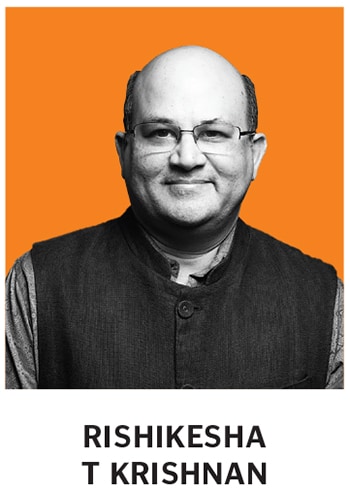Spotlight on India's freedom to innovate
Robust funding to startups and efforts to remove bureaucratic hurdles in government-owned research labs augur well for the future. But freedom to innovate has not been used to solve the most pressing


 The National Research Fund announced as part of the new National Education Policy a year ago should enhance the freedom to innovate in academia by making more research funding available across the higher education system
The National Research Fund announced as part of the new National Education Policy a year ago should enhance the freedom to innovate in academia by making more research funding available across the higher education system
Illustration: Chaitanya Dinesh Surpur
Innovation is driven by people, ideas and capital. In the early decades after Independence, these were constrained by sheer issues of sustenance. Are we now ready and free to soar?
If startup numbers are anything to go by, there is no problem on this score. Literally, thousands of startups have been founded in the last decade and this trend shows no sign of abating soon. Funding is available to help these ideas flower and bloom, and the current stream of big IPOs, and acquisitions and strategic investments should allay any fears of early-stage investors regarding exits.
There are several bright spots in the broader innovation ecosystem. The Universal Payments Interface has provided a powerful ‘public goods’ backbone for fintech innovation, supported by the Reserve Bank of India’s ‘regulatory sandboxes’. Covid-19 has revealed our strong capabilities in rapid innovation of diagnostic test kits and vaccines. Tata Sons recently announced a strategic investment in Tejas Networks, India’s leading telecom tech company and exporter of high-end optical networking equipment. Infosys co-founder Kris Gopalakrishnan is supporting ambitious brain research programmes at the Indian Institute of Science and IIT-Madras. Through the Azim Premji Foundation and related institutions, Azim Premji is supporting the best ideas on how to enhance teaching effectiveness in Indian schools.
It is good to see that the government has recognised the need to remove bureaucratic hurdles to the freedom of innovation in government-owned research laboratories. Based on a review report, India’s premier scientific and industrial research organisation Council of Scientific & Industrial Research has recently worked out a plan to remove many of the internal barriers to innovation.
At the same time, there are challenges. The patient capital that is required to fund long-gestation deep-tech projects is scarce. Family foundations are largely focussed on social and human development, not research and innovation. Flavours of the season tend to dominate venture capital fund flows, leaving high potential ideas in other sectors on an anaemic diet.
Government support to innovation is much better than it was before, but still has gaps. Atal Tinkering Labs had taken the freedom to experiment across the country till Covid-19 constrained access to physical spaces. Through BIRAC, the government’s department of biotechnology has done a wonderful job of catalysing innovation across stages and types of entities (academia, startups, larger companies etc.) to create a vibrant biotech innovation ecosystem, but this success has not been transplanted to other sectors. And, even in biotech, the freedom to grow remains curtailed as scaling up is proving to be a tough nut to crack given the sector’s need for high-cost specialised manufacturing facilities.
Linking ideas to the market is always a challenge. Covid-19 has seen a structured effort by the government to identify needs in diagnostics and treatment, and link these to capabilities in academia and industry. The challenge will be to sustain these linking mechanisms once the pressing challenges of the pandemic pass.
The National Research Fund announced as part of the new National Education Policy a year ago should enhance the freedom to innovate in academia by making more research funding available across the higher education system. Of course, its alignment to national priorities will influence the fund flows to different disciplines and sub-disciplines.
Covid-19 appears to have removed the shackles from Indian academia as far as application-oriented research and development is concerned. It is hoped that this confidence to take up contemporary problems and address them through scalable solutions will sustain well beyond the pandemic.
Unfortunately, the growth of the startup ecosystem seems to have been accompanied by a decline in large industry’s appetite for big-ticket innovation. The Tata Nano, and efforts by several large Indian pharma companies to discover new chemical entities which were prominent during the first decade of this millennium have receded into past memory.

Ironically, freedom and flexibility may not always help innovation. Indian pharma companies were quite happy to rely on Chinese companies for low-cost APIs till Covid-19 and geopolitical tensions threatened to disrupt their supply chains. Now, with government support, we are trying to recover our mojo in this area.
Democratising innovation remains a challenge. Anecdotal evidence suggests that successful startup founders come predominantly from India’s traditional business communities. Bio-incubators in India are located in already well-developed economic hubs. In the last 18 months, the pandemic has significantly constrained access to schooling, with difficult-to-reverse negative implications for a whole generation of under-privileged learners.
Recent developments in China raise interesting questions about the relationship between freedom and innovation. Till a few weeks ago, it appeared that the single-party Chinese political system had not had any negative impact on innovation in that country. On the contrary, China appeared to have made major strides in closing the gap with the developed world. Now the jury is out as we wait to see the implications of the Chinese crackdown on the edtech and fintech sectors. Interestingly, some believe an interesting outcome may be a focus on ‘real tech innovation’ rather than the consumer and valuation-driven innovation of internet companies.
It could be argued that in India, too, the freedom to innovate has not been used to solve the most pressing social and economic problems. Food delivery and ride-hailing apps may have made life easier for the urban middle class, but startup innovation has done little to address India’s biggest challenges like poverty and universal health care. Ironically, some of the most impactful health care innovations—like those of Aravind Eye Care and Narayana Hrudayalaya—come from an earlier era of arguably less ‘freedom to innovate’, but greater idealism and commitment!
The writer is director and professor of strategy at IIM-Bangalore
First Published: Aug 20, 2021, 14:04
Subscribe Now